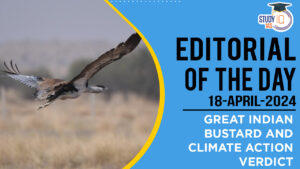Daily Current Affairs for UPSC 2023
Q) Which one of the following statement is not correct about trans-fat?
- They are a form of unsaturated fat.
- Currently, all low-income countries have measure to end trans-fat.
- It increases low-density lipoprotein cholesterol in body.
- WHO released REPLACE guidelines for the elimination of trans-fat.
Daily Current Affairs for UPSC – 30 January 2023
Explanation:
- Option (1) is correct: Trans-fats, or trans-fatty acids, are a form of unsaturated fat. They come in both natural and artificial forms. Natural, or ruminant, trans-fats occur in the meat and dairy from ruminant animals, such as cattle, sheep, and goats. They form naturally when bacteria in these animals’ stomachs digest grass. However, artificial trans-fats otherwise known as industrial trans-fats or partially hydrogenated fats are hazardous to health.
- Option (2) is incorrect: 43 countries have nowimplemented best-practice policies for tackling trans-fat in food, with 2.8 billion people protected globally. Many countries in America and Europe have phased the substance out with bans on partially hydrogenated oils. However, no low-income countries have yet adopted such measures. Currently, 9 of the 16 countries with the highest estimated proportion of coronary heart disease deaths caused by trans-fat intake do not have a best-practice policy. These include Australia, Azerbaijan, Bhutan, Ecuador, Egypt, Iran (Islamic Republic of), Nepal, Pakistan and the Republic of Korea.
- Option (3) is correct: Trans-fats occur when vegetable oils are chemically altered to stay solid at room temperature, which gives them a much longer shelf life. Low-density lipoprotein (LDL) cholesterol or “bad,” cholesterol can build up in the walls of arteries, making them hard and narrow. High-density lipoprotein (HDL) cholesterol “good,” cholesterol picks up excess cholesterol and takes it back to the liver. Trans-fats increase LDL cholesterol and decrease HDL cholesterol, which can increase the risk of heart attack or stroke.
- Option (4) is correct: REPLACE, a step-by-step guide for the elimination ofindustrially-produced trans-fatty acids from the global food supply was released by WHO. REPLACE provides six strategic actions to ensure the prompt, complete, and sustained elimination of industrially-produced trans-fats from the food supply. Trans-fat elimination policies follow specific criteria established by WHO and limit industrially produced trans-fat in all settings. Mandatory national limit of 2 grams of industrially produced trans-fat per 100 grams of total fat in all foods; mandatory national ban on the production or use of partially hydrogenated oils as an ingredient in all foods.
Q) With reference to ‘Pashmina shawls’, consider the following:
- They are made from the wool of the chiru goat.
- The Bakarwal tribe of Jammu and Kashmir is mainly related to the harvest of Pashmina wool.
- Pashmina shawls recently got a geographic indication tag.
Which of the statements given above are not correct?
- 1 and 2 only
- 2 and 3 only
- 1 and 3 only
- 1, 2 and 3
Explanation:
- Statement 1 and 2 are incorrect: Pashmina is the art of producing fine fabric from raw Cashmere wool. It is raw Cashmere which is processed, spun, woven, and formed into Pashmina shawls, stoles, or scarves. It is a GI tagged product. The name Pashmina has been derived from a Persian word “Pashm” meaning a weavable fibre precisely wool. The raw Pashmina is harvested by the Changpa tribes of Ladakh who heard the Changthangi goats.
- Statement 3 is incorrect: On 5 August 2013, Kashmiri Pashmina was given the Geographical Indication (GI) as an authenticity certification. Manufacture of Pashmina is a largely unorganized cottage/handicraft industry providing employment and livelihood to approximately 6 lakh people, most notably to local skilled villagers and artisans in Kashmir. Due to the extremely fragile nature of Cashmere fibre, Kashmiri craftsmen and women have always preferred to use hands while processing it. The strain of a machine would break the fibre, and it would lose its distinctive nature.
Q) Consider the following statements about ‘Uthiramerur Inscriptions’:
- It belongs to King Karikala of the Chola dynasty.
- According to the inscription, the ‘Sabha’ was an assembly of only Brahmins, whereas the ‘Ur’ included members of all social classes.
- To contest a village election, the person must be of 25 years old, as per the inscription.
Which of the statements given above is/are correct?
- 1 and 2 only
- 2 only
- 1 and 3 only
- 1, 2 and 3
Explanation:
- Statement 1 is incorrect: Uthiramerur Inscription date back to the period of Parantaka Chola I (907–950), Rajaraja Chola I (985–1014), Rajendra Chola I (1012–1044) and Kulothunga Chola I (1070–1120), indicates various gifts to the temples. Uthiramerur is a panchayat town in Kancheepuram district in the state of Tamil Nadu. It is noted for its temple inscriptions that describe a self-governance system existing around 7th to 9th century CE.
- Statement 2 is correct: These inscriptions provide details about rural self-governance: The inscriptions indicate that Uthiramerur had two village assemblies. The Sabha was an exclusively Brahmin (priestly class) assembly, while the Ur was made up of people belonging to all the classes.
- Statement 3 is incorrect: As per the inscriptions, every village was categorized as kudumbu (ward in modern day parlance) where representatives of general assembly were elected. The inscription provides details about the qualification for contesting the elections such as, the person must own land, own a house built on legally-owned site, have knowledge of ‘Mantrabrahmana’, and above 35 years of age and below 70 years. If elected members proven guilty of misconduct, they were disqualified from contesting future elections. Village general assembly resolved to choose member for Annual Committee, Garden Committee, and Water bodies Committee.
Q) With reference to ‘Red Headed Vulture’, consider the following:
- It is endemic to the Indian subcontinent.
- In India, the population of this vulture has increased over the last two decades.
- It is listed as critically endangered on the IUCN Red List of Species.
Which of the statements given above is/are correct?
- 1 and 2 only
- 2 and 3 only
- 3 only
- 1, 2 and 3
Explanation:
- Statements 1 and 2 are incorrect: The Red-headed vulture, also known as the Asian king vulture, Indian black vulture or Pondicherry vulture, is an Old World vulture mainly found in the India and in some parts of Southeast Asia. India has lost almost 94% of this species, through consumption of livestock treated with the veterinary NSAID drugs like Diclofenac, carprofen, flunixin, ibuprofen and phenylbutazone. Recently, Red Headed Vulture (Sarcogyps calvus) has been seen in Asola Bhatti Wildlife Sanctuary of Delhi.
- Statement 3 is correct: Red Headed Vulture is listed as critically endangered in the IUCN Red list of species, in Schedule-1 of the Wildlife Protection Act, 1972 and Annexure 1 of the Convention of Migratory Species (CMS) framework. The government has devised an Action Plan for Vulture Conservation in India (2020-2025). It includes:
- Prevention of poisoning of cattle carcasses, the principal food of vultures.
- Enhancement of Conservation Breeding Programme.
- Regular monitoring of vulture populations across the country.
- Enhancing the vulture safe zone network by creating at least one vulture safe zone in each state and continuing to work on the existing efforts of vulture safezone.
- Determining and preventing other causes of mortality.
Q) Consider the following statements ‘Neuromorphic computing’:
- It aims to replicate a biological synapse in the human brain that monitors the signal produced by a given stimuli.
- It can potentially be used in next-generation semiconductors and transistors.
Which of the statements given above is/are correct?
- 1 only
- 2 only
- Both 1 and 2
- Neither 1 nor 2
Explanation:
- Statement 1 is correct: Neuromorphic computing is a method of computer engineering in which elements of a computer are modeled after systems in the human brain and nervous system. The development of neuromorphic hardware aims at mimicking a biological synapse that monitors and remembers the signal generated by the stimuli. The traditional computers have physically separated memory storage and processing units. As a result, it takes enormous energy and time to transfer data between these units during an operation. On the contrary, the human brain is a supreme biological computer that is smaller and more efficient due to the presence of a synapse (the connection between two neurons) that plays the role of both processor and memory storage unit. This is what the Neuromorphic computing aims to mimic.
- Statement 2 is correct: The new invention can provide a new material for stable, CMOS-compatible optoelectronic synaptic functionalities at a relatively lower energy cost and hence has the potential to be translated into an industrial product. Neuromorphic technology is expected to be used in the following ways:
- Deep learning applications
- Next-generation semiconductors
- Transistors
- Accelerators
- Autonomous systems, such as robotics, drones, self-driving cars and artificial intelligence (AI).


 Editorial of the day (18th Apr): Great I...
Editorial of the day (18th Apr): Great I...
 Expansion of Universe, Speed, Reasons, I...
Expansion of Universe, Speed, Reasons, I...
 Current Affairs 18th April 2024 for UPSC...
Current Affairs 18th April 2024 for UPSC...

















